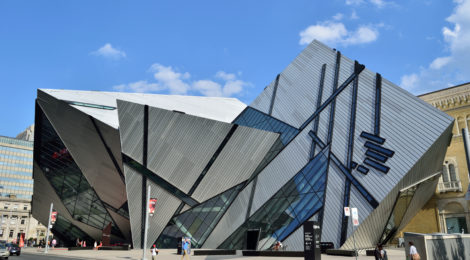
Royal Ontario Museum – ROM
The Royal Ontario Museum located on the northeast corner of the University of Toronto’s expansive campus was founded in 1912 and opened to the public in 1914. Renovated and expanded in 2007, this museum features exhibits ranging from biology and biodiversity to human art and history. It’s one of the largest museums in North America, and the biggest in Canada, I did a whirlwind tour of it in 4 hours, but I would suggest a full day to see it in all its glory. The dinosaur exhibit is particularly impressive and houses the biggest mounted dinosaur fossil in Canada. There are very nice exhibits for children and a section where they can try on period costumes as well as practice digging for dinosaurs. A new exhibit had yet to arrive covering the beginnings of life in the Precambrian, though from the sneak preview available it looks thoroughly entertaining. The earth science exhibit features marvelous collections of precious stones and rare minerals with every sort of metal and crystal in between exposed in brilliant displays.
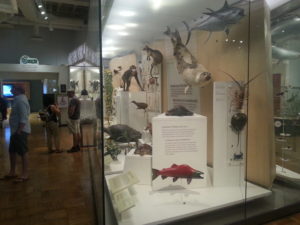
ROM – Biodiversity Exhibit
One of the particularly interesting live animals the ROM has in partnership with the Toronto Zoo is a pair of axolotls, little amphibians from Mexico who are greatly endangered by pollution in the wild. The axolotls are fed earth worms on Sundays and blood worms on Wednesday, according to their caretaker, they seem to prefer the earth worms. The most interesting aspect of this little creature is its ability to regenerate nearly any part of its anatomy within a few weeks. The pair at the ROM sometimes mate and the female will lay a clutch of eggs, these are too fragile to be removed before hatching and so the caretakers must watch over them until they hatch because mommy and daddy have a tendency to gobble up their young. This has been attributed to the axolotls having terrible eyesight and not being able to identify what it is exactly they’re eating.

Axolotl – photo credit: th1098 Wiki Commons.
As it’s not the focus of this website I’ve only glossed over the biological and earth science exhibits, though I would still recommend them in their own right. Now on with the show, the ROM has permanent exhibits covering most human civilisation to an extent and an expansive collection of artifacts from each is displayed in large open spaces allowing an easy visit even on crowded days.
On the first floor is a large room dedicated to the Canadian First Nations and has an emphasis on the role they played during the War of 1812. In Eastern Canada, the natives primarily used the birch bark canoe for transportation, trade as well as raiding. These larger canoes, called Rabaska, were big enough to accommodate a war party of up to 20 men in a pinch or 8 men and their cargo of furs on a long journey from the North West Territories to Montreal. The construction of such reliable and versatile boats is detailed here. The weapons of the First Nations prior to the arrival of European colonists were as a matter of fact from the stone age, though exposed to metal blades and fire arms, the First Nation warriors were quick to adapt these new tools to their tactics. The Natives were employed as scouts and sharp-shooters by the colonial powers in times of war, their guerrilla tactics often diametrically opposed to the standard line fight European commanders were accustomed to. The construction of a short hunting bow and flint knapping methods used by First Nations people prior to the arrival of metals and guns were at one point instrumental to the survival of humans from everywhere around the world. Another type of boat used by First Nations, this time the Inuits, is the seal skin kayak whose primary structure can resemble the canoe’s frame, but it’s covered top allowed an over turned kayak to be righted, it’s specific construction and history’s detailed here.
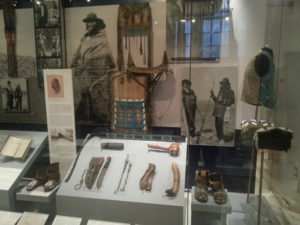
ROM – First Nation Exhibit
Adjoining the First Nations’ Exhibit is the Canadian History hall which holds artifacts from Canada’s colonial past, both from daily life and military events. There are paintings of Wolf and Montcalm from the Battle of the Plains Abraham (1759) on the outskirts of Quebec ending both its siege and French presence on the continent. This siege is also know for it’s use of ship to shore bombardments with heavy use of mortars loaded with shells and carcasses as well as the use of fire ships by the French beleaguered forces in an attempt to burn Wolf’s fleet. There’s a nice section of oil paintings depicting naval engagements of the Royal Navy in and around Canadian waters and well preserved brass sextants which revolutionised ocean navigation.
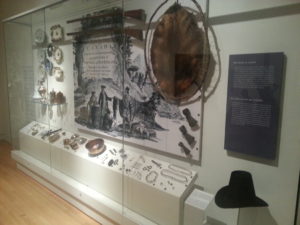
ROM – Canadian History Exhibit
On the opposing end of the first floor is the Asian cultures exhibits, which houses a very large collection of daily life artifacts as well as some distinct military tools of the region. There are some large architectural structures in the hall displaying the craftsmanship necessary to produce these functional art forms, as displayed in the picture below. All Asian exhibits had a vast array of paintings, pottery and jewelry on display as well as furniture arrayed in typical rooms.
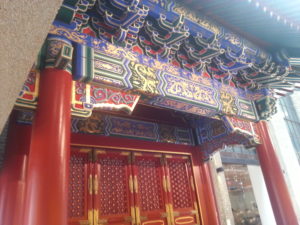
ROM – Korean Temple Entrance
There is a very nice collection of Japanese samurai armour as well as katana’s who’s construction were a labour of care by expert blacksmiths. There were also some oddities including a pistol camouflaged as a dagger and firearms which were used briefly in Japan until they fell out of fashion in the Edo period due to isolationist policies and relative peace. The Chinese portion of the exhibit featured many bronze age swords, daggers, axes and spearheads as well as a chariot harness and some toy soldier figurines. The development of iron tools is also on display with not only swords and axe-heads but with the manufacture of war machines such as the crossbow. Finally, the Korean exhibit has a heavy focus on the housing and the structure of towns with the 2 court yard houses.
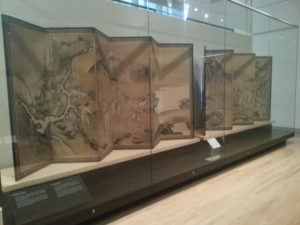
ROM – Japanese Paintings
On the second floor is the Roman, Byzantine, Greek and Egyptian displays, cover the advances of these civilisations from the bronze age through the classical period and into the iron age, of course with the Byzantine empire lasting well into the late middle ages. The Egyptian section centered mostly around agricultural and construction tools as they progressed through the ages, where one can see two ceremonial flinted knife of different periods, and yes, they have a mummy. The Greek and Mycenaean displayed pottery and sculptures depicting feats of arms as well as a large amount of coinage. The Etruscan section covered the early rivals of Rome and their use of the phalanx, which the early Roman army defeated. There is a collection of roman spears and javelin known as pilum whose soft iron shaft would bend upon impact preventing the enemy from throwing them back. Roman armies were also known for the use of heavily shielded infantry wielding short swords known as gladius, and in later periods the spatha which would become the basis for the migratory period swords.
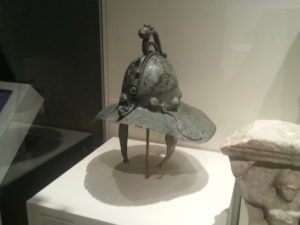
ROM – Gladiator Helmet from Coloseum
On the opposite end of the second floor is the evolution of European Arms and Armour and the European Styles exhibits where artefacts are laid out in rooms typical of the fashion of the period. The arms and armour portion covers most styles from the sword and chainmail of the viking period all the way to the automatic weapons of the First World War. Full, three-quarter and half plate harnesses are on display from both the late middle ages as well as the renaissance period and the appearance of pike and shot formations. Armour was designed not only for adult men, it was also made for children, (the two sets of armour on the right in the display) so they could learn and get accustomed to their usage. There is a noted difference between the armours of the joust and battle ready harnesses meant for warfare, as the two evolved they became ever separate entities. There is a small collection of firearms which included French duelling pistols, arquebus, muskets and early rifles.
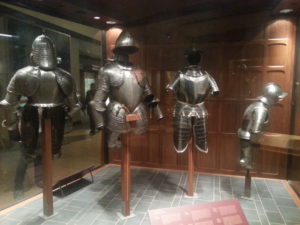
ROM – European Arms and Armour Exhibit
Visited: 19-06-2016
Featured Picture Credit: Raysonho @ Open Grid Scheduler / Grid Engine – Own work, CC0, https://commons.wikimedia.org/w/index.php?curid=40520916
